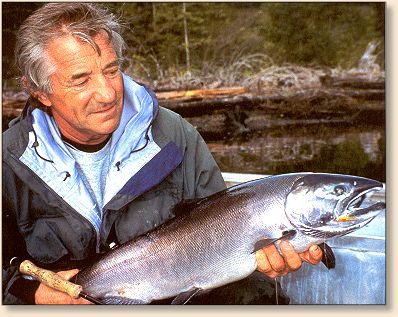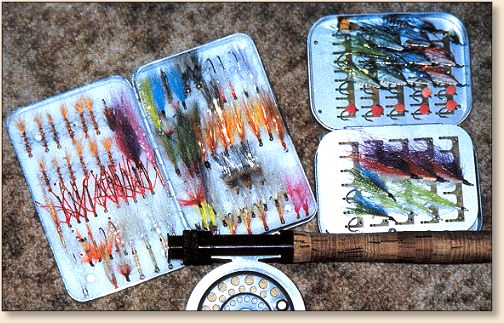When you mention Belize to fly anglers they don wide
smiles and conjure up visions of warm tropical breezes,
unrelenting sunshine, white sandy beaches, and wading
shallow salt-water flats while casting to Permit and
Bonefish. When you mention Belize. . . Inlet, on Canada's
West Coast, all you get are blank stares. But the
chrome-bright, wild coho salmon this northern Belize
are pursued by many fly fisher with as much fervor as
their exotic counterparts are pursued in the tropical
Belize. True, the sticky mud-flats of Belize Inlet are
a far cry from the white, sandy beaches of Central America,
and the breezes there are more likely to raise goose
bumps than a thirst. But the coho conjure challenge
and excitement equal to anything the tropics have to
offer.
The Belize and Seymour Inlets complex.
Situated within B.C.'s South-Central coast-roughly, that
bit of mainland real estate directly beyond the northern
tip of Vancouver Island-are many fjord-like waters. Belize
and Seymour Inlets are two of these, which come together
as one and spill into the Pacific through the treacherous
Nakwakto Rapids-reputedly the fastest surging piece of
tidal water on the coast with currents of thirty kilometres
per hour.
Many of the famous inlets along B.C.'s South coast, such
as Bute, Toba, Knight, have become crowded, busy havens
for the yachting set attracted by the easy sailing. Nakwakto,
however, is a bit too formidable for most casual day-trippers,
and very few anglers venture there. Consequently, the fish
stocks in this area are much less heavily harvested than
places which are more easily accessed. But beyond the
treacherous rapids at the mouth, both of these long narrow
inlets are tucked-in tight to the mountains beyond the
frontal assault of ocean weather, making them relatively
storm proof. Poking around the various bays and estuaries,
searching the shoreline for stops of interest ("gunkholing"
as some call it) is a pleasant way of finding fish.
Cruising to Belize.
The challenge of besting Nakwakto Rapids is not for the
faint of heart, nor for the inexperienced sailor.
Interpreting and understanding the tide and current charts
for the area are key to successfully and safely running
the rapids. The best way to get through that piece of
troubled water is to go with an experienced boat operator.
There are several coastal eco-tour operations who shoot
the rapids, but only a small handful of fishing guides
who do it. The town of Port Hardy on northern Vancouver
Island is the base for most of these guides. That's where
I found Captain Lloyd Heskin, owner/operator of Nature's
Best Wilderness Tours. Lloyd has the only service offering
specialized fly-fishing adventure cruises into the remote
Belize-Seymour complex.
Nature's Best utilizes a fifty-foot, steel-hulled vessel--the
MV Lasqueti Star-to cruise the inlets. This boat is fully
outfitted to live aboard in comfort and style-complete
with a large galley (with a chef), laundry facilities,
two full bathrooms, and four private staterooms. Lloyd
runs the adventures in the "mothership and skiff" concept:
the big boat is for traveling long distances and is the
base of operations for short haul exploratory fishing trips
to nearby waters in sturdy outboard powered aluminum skiffs.
Should the weather turn sour or the fishing not pan-out as
hoped, you just motor back to the mothership to dry off
or to make a run to more productive waters.

Remote inlet fishing for wild fish
Last year, I made two trips with Lloyd on his Lasqueti Star,
one in the spring, the other in the fall. I was one of four
writer-flyfishers aboard (the others were Bob Scammell,
Jack Simpson, and Bob Jones). The spring trip, in mid-May,
was an exploratory excursion for researching the potential
of catching sea-run cutthroat trout.
These enigmatic little fish offer some fine early season
salt-water fly-rodding when you can find them. As a
retired commercial fisherman, Lloyd already knew a lot
about salmon and where to find them, but was still
learning about the habits of cutthroats in the salt.
Nevertheless, it didn't take him long to find them.
All we had to do was catch.
Along with the cutthroats we also found some nice "bluebacks,"
a colloquial name for sub-adult feeding coho salmon. This
mixed bag of twelve-to-fourteen inch cutts and coho to
about sixteen inches kept us nicely entertained. As this
was an exploratory trip, we did a lot of cruising around
to various back-bays and estuaries in hope of learning
more about what this area had to offer. On a real fly-fishing
adventure we would have spent as much time as we liked in
places where the action was hot.

The second trip in early October for silver-bright coho
was a mainline fishing fix. I was a shipmate of another
hard-core fly-fisher, Ron deFoy, whose mission was to
pound the fishing hard and help shoot some video of the
action. This trip paid-off big time. We found several
places where we saw migrating coho jumping and rolling
as they milled about in shallow bays. It was simply a
matter of anchoring the mothership then launching a skiff
and quietly motoring over to the action.
Coho weren't the only fish available. Chum salmon were
also in abundance. Unlike most streams on Vancouver Island,
where they make their runs after the coho, on the central
coast streams chums make their runs first. This means that
the chum offer an earlier fishery, starting as early as
the beginning of September. Chum are large powerful salmon,
which have only recently gained mainstream respectability
as a fly rod target.
While we didn't pursue them on these trips, steelhead are
known to run into several of the streams in the Belize-Seymour
complex. In keeping with other mainland coast streams, the
most likely timing for these runs would be early spring,
probably March and April. Lloyd is entertaining the idea
of taking folks on steelhead trips and is researching the
necessary requirements to offer such adventures.
Tackle and technique.
As fly fishers have been targeting salmon in the salt for
some time now, the tackle and techniques required for
successfully catching them is well-established. Fly rods
range from nine to ten feet, balanced with a seven to
ten-weight line. The reel (preferably large arbour) should
have a good drag and capacity for a couple hundred yards
of backing. For sea-run cutthroats and early season bluebacks
a lighter outfit, say in a five or six-weight designation
is more appropriate for these smaller fish.
As most of the target areas are shallow bays and estuaries,
sink-tip and intermediate sinking lines are the general rule,
although there places where you can get away with a full
floater for fishing dry flies for cutthroat. I've found
that the best all-round line for both coho and cutthoats
is a clear sinker, reserving the sink-tip for the deeper
drop-offs at river mouths.
 The fly patterns used elsewhere for salt-water salmon and
cutthroats which have been proved effective elsewhere also
work in Belize Inlet. Most popular baitfish and attractor
patterns should work, but we found the following produced
particularly well for us: Muddler Minnows, Pearl Mickeys,
Coronation Bucktails, and Lefty's Deceivers. The most
effective colour was chartreuse over white polar bear hair,
and all should be tied with Clouser style, heavy-metal
dumbell eyes.
The fly patterns used elsewhere for salt-water salmon and
cutthroats which have been proved effective elsewhere also
work in Belize Inlet. Most popular baitfish and attractor
patterns should work, but we found the following produced
particularly well for us: Muddler Minnows, Pearl Mickeys,
Coronation Bucktails, and Lefty's Deceivers. The most
effective colour was chartreuse over white polar bear hair,
and all should be tied with Clouser style, heavy-metal
dumbell eyes.
The allure of wilderness adventure.
There is much to be said these harried days for having a
bit of wilderness to enjoy. The Belize-Seymour complex offers
a portal to remote hillsides and river valleys where grizzly
bears, mountain goats and bald eagles roam freely; where
salmon run in untold numbers; and where the air is crystal
clear with just a hint of salty tang. This central coast
area overlaps what has come to be known as the Great Bear
Rainforest. That name alone conjures visions of wild, dank,
untamed places.
The experience of traveling and exploring these waters by
live-aboard boat far overshadows the alternative, the
expensive hit-and-run interloper concept of dropping
in by helicopter. Fly fishers easily become absorbed
in the surroundings, spending both their days and nights
in communion with the wilderness. Fly-casting to wild
fish in wild surroundings is a powerful restorative tonic.
Now that there is a fly fishing outfitter servicing these
wild places, taking that medicine just became a little
more pleasant. ~ REG
We thank the
Canadian Fly Fisher for re-print permission!
| |

